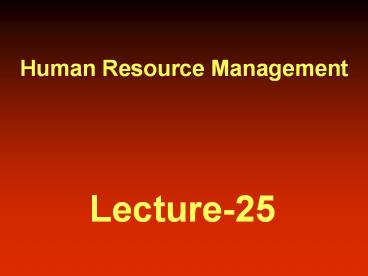Human Resource Management - PowerPoint PPT Presentation
Title:
Human Resource Management
Description:
Human Resource Management Lecture-25 Career (cont..) Internal Barriers to Career Advancement Lack of time, budgets, and resources for employees to plan their careers ... – PowerPoint PPT presentation
Number of Views:209
Avg rating:3.0/5.0
Title: Human Resource Management
1
Human Resource Management
- Lecture-25
2
Career (cont..)
3
Internal Barriers to Career Advancement
- Lack of time, budgets, and resources for
employees to plan their careers and to undertake
training and development. - Rigid job specifications, lack of leadership
support for career management, and a short-term
focus. - Lack of career opportunities and pathways within
the organization for employees.
4
Successful Career-Management Practices
- Placing clear expectations on employees.
- Giving employees the opportunity for transfer.
- Providing a clear succession plan
- Encouraging performance through rewards and
recognition. - Encouraging employees to continually assess their
skills and career direction. - Giving employees the time and resources they need
to consider short- and long-term career goals.
5
Individual and Organizational Perspectives on
Career Planning
6
Organization
Work to achieve good person-organization fit
through selection
Stronger and more effective workforce
Effective career planning
Understand and monitor career opportunities,
successes, and failures
More successful and healthier career
Individual
7
Performance
- Performance AES
- A Ability
- E Effort
- S Organizational Support
8
Why Do We Care?
Ability
PERFORMANCE
Opportunity
Motivation
Performance f (Ability, Motivation,
Opportunity)
9
Determinants of Job Performance
Willingness to perform
Job performance
Capacity to perform
Opportunity to perform
10
Sample Core Performance Indicators
11
Financial (Economic) Perspective
- How do we look to shareholders?
- Survive Cash flow
- Maintain Quarterly sales growth and
operating income - Prosper Increased market share, profit,
ROI / value-added
12
Customer Perspective
- How do our customers experience us?
- New products Percent of sales derived from
new products - Value Competitive pricing, product
quality - Brand loyalty Market share
- Customer satisfaction Repeat business,
response time, accuracy and minimal
product returns
13
Innovation, Learning and Equity
- How can we sustain our success?
- Leadership Staff development and
learning, participation - Staff stability Employee retention /
turnover trends satisfaction
loyalty - Innovation Continuous process improvement
and redesign, creativity valued
14
Internal Business (Operational) Perspective
- What must we excel at?
- Manufacturing excellence
- Product develop cycle time, unit cost,
time to market - Design productivity
- Efficiency (output per labor cost),
material yields
15
Performance
Environment
Outcome
Performance
Effort
Motivation
Ability
16
Factors that influence whether performance will
be sustained
- Valid performancemeasurement
- Value of rewardand negative consequence
- Ongoing feedback
Job Performance
17
Why is performance measured?
- Enhances motivation productivity
- Assists in validation studies
- Detects problems
- Helps evaluate change efforts
- Provides basis for making decisions
- Differentiates employees in job-related areas
- Helps ensure legal compliance
18
What Is Measured?
19
- Dimensions against which performance is evaluated
20
Performance Management
- A means of getting better results by
understanding and managing performance within an
agreed framework of planned goals, standards and
competence requirements. - It is a process to establish a shared
understanding about what is to be achieved, and
an approach to managing and developing people(so
that it) will be achieved.
21
- Goal
- Improve the effectiveness efficiency of the
organization by - Aligning the employees work behaviors results
with the organizations goals - Improving the employees work behaviors results
- On-going, integrative process































